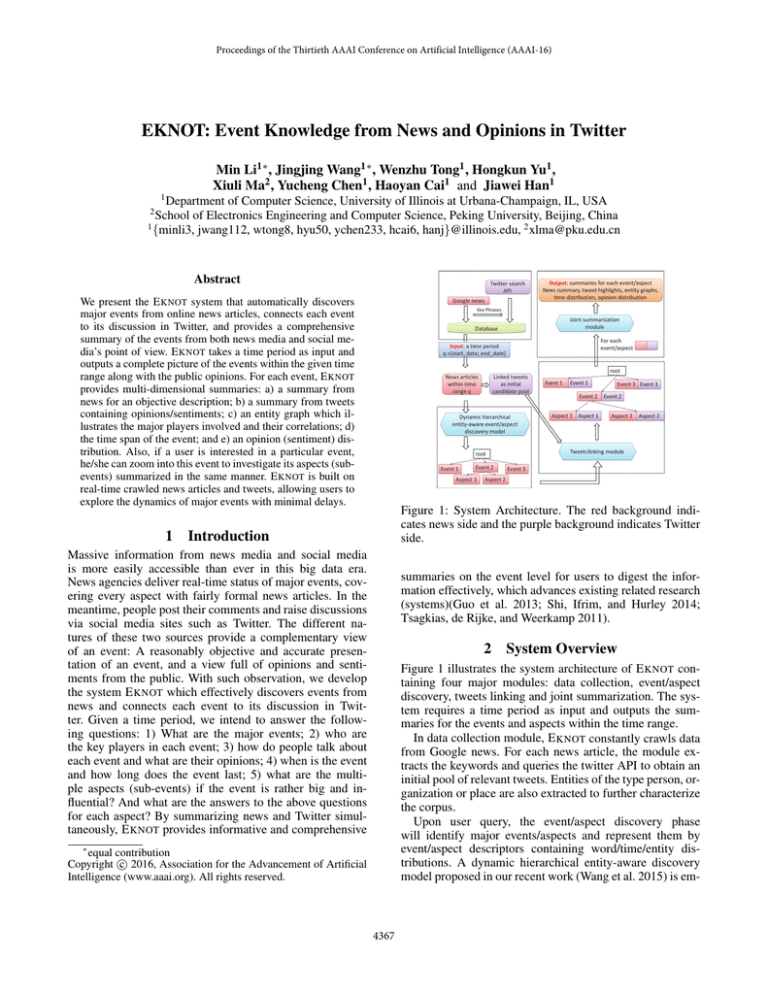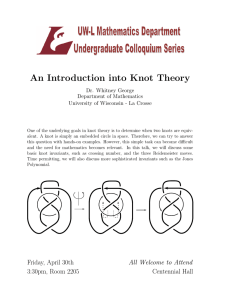
Proceedings of the Thirtieth AAAI Conference on Artificial Intelligence (AAAI-16)
EKNOT: Event Knowledge from News and Opinions in Twitter
Min Li1∗ , Jingjing Wang1∗ , Wenzhu Tong1 , Hongkun Yu1 ,
Xiuli Ma2 , Yucheng Chen1 , Haoyan Cai1 and Jiawei Han1
1
Department of Computer Science, University of Illinois at Urbana-Champaign, IL, USA
School of Electronics Engineering and Computer Science, Peking University, Beijing, China
1
{minli3, jwang112, wtong8, hyu50, ychen233, hcai6, hanj}@illinois.edu, 2 xlma@pku.edu.cn
2
Abstract
We present the E KNOT system that automatically discovers
major events from online news articles, connects each event
to its discussion in Twitter, and provides a comprehensive
summary of the events from both news media and social media’s point of view. E KNOT takes a time period as input and
outputs a complete picture of the events within the given time
range along with the public opinions. For each event, E KNOT
provides multi-dimensional summaries: a) a summary from
news for an objective description; b) a summary from tweets
containing opinions/sentiments; c) an entity graph which illustrates the major players involved and their correlations; d)
the time span of the event; and e) an opinion (sentiment) distribution. Also, if a user is interested in a particular event,
he/she can zoom into this event to investigate its aspects (subevents) summarized in the same manner. E KNOT is built on
real-time crawled news articles and tweets, allowing users to
explore the dynamics of major events with minimal delays.
1
Figure 1: System Architecture. The red background indicates news side and the purple background indicates Twitter
side.
Introduction
Massive information from news media and social media
is more easily accessible than ever in this big data era.
News agencies deliver real-time status of major events, covering every aspect with fairly formal news articles. In the
meantime, people post their comments and raise discussions
via social media sites such as Twitter. The different natures of these two sources provide a complementary view
of an event: A reasonably objective and accurate presentation of an event, and a view full of opinions and sentiments from the public. With such observation, we develop
the system E KNOT which effectively discovers events from
news and connects each event to its discussion in Twitter. Given a time period, we intend to answer the following questions: 1) What are the major events; 2) who are
the key players in each event; 3) how do people talk about
each event and what are their opinions; 4) when is the event
and how long does the event last; 5) what are the multiple aspects (sub-events) if the event is rather big and influential? And what are the answers to the above questions
for each aspect? By summarizing news and Twitter simultaneously, E KNOT provides informative and comprehensive
summaries on the event level for users to digest the information effectively, which advances existing related research
(systems)(Guo et al. 2013; Shi, Ifrim, and Hurley 2014;
Tsagkias, de Rijke, and Weerkamp 2011).
2
System Overview
Figure 1 illustrates the system architecture of E KNOT containing four major modules: data collection, event/aspect
discovery, tweets linking and joint summarization. The system requires a time period as input and outputs the summaries for the events and aspects within the time range.
In data collection module, E KNOT constantly crawls data
from Google news. For each news article, the module extracts the keywords and queries the twitter API to obtain an
initial pool of relevant tweets. Entities of the type person, organization or place are also extracted to further characterize
the corpus.
Upon user query, the event/aspect discovery phase
will identify major events/aspects and represent them by
event/aspect descriptors containing word/time/entity distributions. A dynamic hierarchical entity-aware discovery
model proposed in our recent work (Wang et al. 2015) is em-
∗
equal contribution
c 2016, Association for the Advancement of Artificial
Copyright Intelligence (www.aaai.org). All rights reserved.
4367
ployed to learn the optimal representation of the news events
and their multiple aspects in a top-down manner. The model
integrates text, entities and time with the intuition that an
event/aspect must be coherent in all these dimensions. We
then retrieve the most relevant tweets from the initial pool by
standard information retrieval with BM251 using the event’s
word distribution as the query.
After event discovery in news and tweets, we co-rank the
two sources to obtain event news summaries and tweet highlights in the joint summarization module. The co-ranking
phase considers a) content and temporal consistency with the
event/aspect; b) coherence between the news summary and
tweet summary; c) coverage and diversity of the news(tweet)
summary; and d) whether the tweet summary contains substantial opinions/sentiments and represents a general trend
of the public. E KNOT combines Co-HITS (Deng, Lyu, and
King 2009) and the Maximal Marginal Relevance (MMR)
principle (Carbonell and Goldstein 1998) to determine the
top ranked news and tweets. The sentiment analysis was
achieved by a two-step classification model (Barbosa and
Feng 2010).
Together with the news summaries and tweet highlights,
E KNOT also provides the following information to facilitate
event understanding:
• Entity Graphs: E KNOT generates the entity graph based
on the computed entity distributions. The relative importance of the entity and correlation between two entities
are denoted by the node size and edge width.
• Time Spans: E KNOT utilizes the time distribution in the
descriptor to approximate the time span.
• Opinion Graph: E KNOT shows the positive and negative
percentage of the event tweets in a pie chart.
3
Figure 2: Aspect Details
UIUC. Xiuli Ma is supported by the National Natural Science Foundation of China under Grant No.61103025 and
China Scholarship Council.
Demonstration Plan
We start the demonstration by issuing a time period query.
E KNOT first returns the event display page which displays
all the major events within this period. Users can choose any
event to see the event details and inspect its aspects. “Event
Details” page displays the summary of the event.On the
“Event Aspects” page, a list of aspects will be displayed as illustrated in Figure 2. This figure displays two
sample aspects related to the March 2015 Apple Event: one
is about Apple Watch and the other about MacBook. We are
able to see the time spans on the top, news summaries on
the left, tweet highlights on the right, following by an entity
graph and a pie chart showing the sentiment distribution.
References
Barbosa, L., and Feng, J. 2010. Robust sentiment detection
on twitter from biased and noisy data. COLING Posters.
Carbonell, J., and Goldstein, J. 1998. The use of mmr,
diversity-based reranking for reordering documents and producing summaries. SIGIR, 335–336.
Deng, H.; Lyu, M. R.; and King, I. 2009. A generalized cohits algorithm and its application to bipartite graphs. KDD,
239–248.
Guo, W.; Li, H.; Ji, H.; and Diab, M. T. 2013. Linking tweets
to news: A framework to enrich short text data in social media. ACL, 239–249.
Shi, B.; Ifrim, G.; and Hurley, N. 2014. Insight4news: Connecting news to relevant social conversations. ECMLPKDD,
473–476.
Tsagkias, M.; de Rijke, M.; and Weerkamp, W. 2011. Linking online news and social media. WSDM, 565–574.
Wang, J.; Tong, W.; Yu, H.; Li, M.; Ma, X.; Cai, H.; and
Han, J. 2015. Mining multi-aspect reflection of news events
in twitter: Discovery, linking and presentation. ICDM.
Acknowledgment
Research was sponsored in part by the U.S. Army Research
Lab. under Cooperative Agreement No. W911NF-09-20053 (NSCTA), National Science Foundation IIS-1017362,
IIS-1320617, and IIS-1354329, HDTRA1-10-1-0120, and
grant 1U54GM114838 awarded by NIGMS through funds
provided by the trans-NIH Big Data to Knowledge (BD2K)
initiative (www.bd2k.nih.gov), and MIAS, a DHS-IDS Center for Multimodal Information Access and Synthesis at
1
http://en.wikipedia.org/wiki/Okapi BM25
4368





